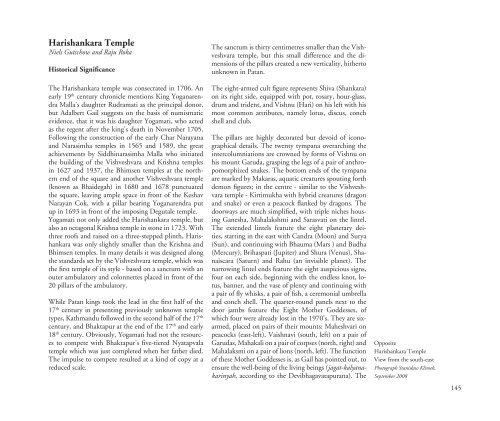KVPT’s Patan Darbar Earthquake Response Campaign - Work to Date - September 2016
You also want an ePaper? Increase the reach of your titles
YUMPU automatically turns print PDFs into web optimized ePapers that Google loves.
Harishankara Temple<br />
Niels Gutschow and Raju Roka<br />
His<strong>to</strong>rical Significance<br />
The Harishankara temple was consecrated in 1706. An<br />
early 19 th century chronicle mentions King Yoganarendra<br />
Malla's daughter Rudramati as the principal donor,<br />
but Adalbert Gail suggests on the basis of numismatic<br />
evidence, that it was his daughter Yogamati, who acted<br />
as the regent after the king's death in November 1705.<br />
Following the construction of the early Char Narayana<br />
and Narasimha temples in 1565 and 1589, the great<br />
achievements by Siddhinarasimha Malla who initiated<br />
the building of the Vishveshvara and Krishna temples<br />
in 1627 and 1937, the Bhimsen temples at the northern<br />
end of the square and another Vishveshvara temple<br />
(known as Bhaidegah) in 1680 and 1678 punctuated<br />
the square, leaving ample space in front of the Keshav<br />
Narayan Cok, with a pillar bearing Yoganarendra put<br />
up in 1693 in front of the imposing Degutale temple.<br />
Yogamati not only added the Harishankara temple, but<br />
also an octagonal Krishna temple in s<strong>to</strong>ne in 1723. With<br />
three roofs and raised on a three-stepped plinth, Harishankara<br />
was only slightly smaller than the Krishna and<br />
Bhimsen temples. In many details it was designed along<br />
the standards set by the Vishveshvara temple, which was<br />
the first temple of its style - based on a sanctum with an<br />
outer ambula<strong>to</strong>ry and colonnettes placed in front of the<br />
20 pillars of the ambula<strong>to</strong>ry.<br />
While <strong>Patan</strong> kings <strong>to</strong>ok the lead in the first half of the<br />
17 th century in presenting previously unknown temple<br />
types, Kathmandu followed in the second half of the 17 th<br />
century, and Bhaktapur at the end of the 17 th and early<br />
18 th century. Obviously, Yogamati had not the resources<br />
<strong>to</strong> compete with Bhaktapur's five-tiered Nyatapvala<br />
temple which was just completed when her father died.<br />
The impulse <strong>to</strong> compete resulted at a kind of copy at a<br />
reduced scale.<br />
The sanctum is thirty centimetres smaller than the Vishveshvara<br />
temple, but this small difference and the dimensions<br />
of the pillars created a new verticality, hither<strong>to</strong><br />
unknown in <strong>Patan</strong>.<br />
The eight-armed cult figure represents Shiva (Shankara)<br />
on its right side, equipped with pot, rosary, hour-glass,<br />
drum and trident, and Vishnu (Hari) on his left with his<br />
most common attributes, namely lotus, discus, conch<br />
shell and club.<br />
The pillars are highly decorated but devoid of iconographical<br />
details. The twenty tympana overarching the<br />
intercolumniations are crowned by forms of Vishnu on<br />
his mount Garuda, grasping the legs of a pair of anthropomorphized<br />
snakes. The bot<strong>to</strong>m ends of the tympana<br />
are marked by Makaras, aquatic creatures spouting forth<br />
demon figures; in the centre - similar <strong>to</strong> the Vishveshvara<br />
temple - Kirtimukha with hybrid creatures (dragon<br />
and snake) or even a peacock flanked by dragons. The<br />
doorways are much simplified, with triple niches housing<br />
Ganesha, Mahalakshmi and Sarasvati on the lintel.<br />
The extended lintels feature the eight planetary deities,<br />
starting in the east with Candra (Moon) and Surya<br />
(Sun), and continuing with Bhauma (Mars ) and Budha<br />
(Mercury), Brihaspati (Jupiter) and Shura (Venus), Shanaiscara<br />
(Saturn) and Rahu (an invisible planet). The<br />
narrowing lintel ends feature the eight auspicious signs,<br />
four on each side, beginning with the endless knot, lotus,<br />
banner, and the vase of plenty and continuing with<br />
a pair of fly whisks, a pair of fish, a ceremonial umbrella<br />
and conch shell. The quarter-round panels next <strong>to</strong> the<br />
door jambs feature the Eight Mother Goddesses, of<br />
which four were already lost in the 1970’s. They are sixarmed,<br />
placed on pairs of their mounts: Maheshvari on<br />
peacocks (east-left), Vaishnavi (south, left) on a pair of<br />
Garudas, Mahakali on a pair of corpses (north, right) and<br />
Mahalaksmi on a pair of lions (north, left). The function<br />
of these Mother Goddesses is, as Gail has pointed out, <strong>to</strong><br />
ensure the well-being of the living beings (jagat-kalyanakarinyah,<br />
according <strong>to</strong> the Devibhagavatapurana). The<br />
Opposite<br />
Harishankara Temple<br />
View from the south-east<br />
Pho<strong>to</strong>graph Stanisław Klimek,<br />
<strong>September</strong> 2008<br />
145




